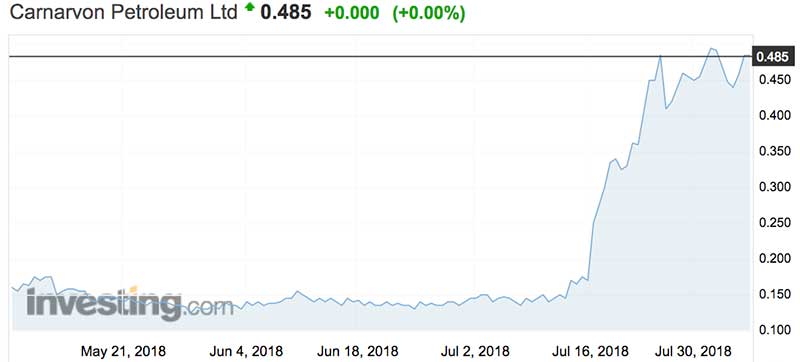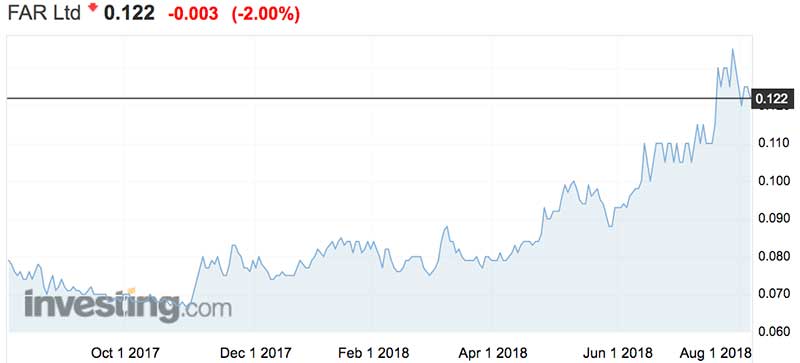You don’t need to look FAR for the next Carnarvon

Pic: Vertigo3d / E+ via Getty Images
Tim Treadgold writes his Explorer column weekly for Stockhead
Investors who enjoyed a 200 per cent increase in the value of their shares in Carnarvon Petroleum over the past month might be looking for the next big hit.
We wrote about Carnarvon in May when the stock (ASX:CVN) was trading at 16c. It had a low profile then thanks to a lack of exploration success and limited interest in oil exploration after the spectacular fall in the price of oil in mid-2014.
Carnarvon rocketed to a nine-year high of 52c last week before easing back to 44c as traders took their profits.
Its success followed the discovery of what looks to be a commercially viable discovery in its part-owned Dorado well off the north-west coast of WA, with more possibly to come from a second nearby well being drilled, South Phoenix No.3.

What better place to look for the next big hit than another small oil stock close to drilling what could be a company-making well — FAR Ltd.
FAR, which was once called First Australian Resources, has similarities to Carnarvon which ought to earn it a place on a resource-investors research list if only because of the advice given last century by one of the world’s richest men.
It was oil billionaire J. Paul Getty who said his formula for success was: “rise early, work hard, strike oil”.
Melbourne-based FAR has already come close its Getty (or Carnarvon) moment and would probably have a much higher profile with investors if not for the mid-2014 oil-price crash.
In one of the investment world’s best examples of unfortunate timing FAR made its first big oil strike in late 2014, and even though the SNE-1 off the coast of Senegal in West Africa, was hailed as the world’s best oil discovery of 2014 it was the falling oil price of that year which made the news.
It’s been a slow road back for FAR with hiccups along the way, including a disputed sale by one of its partners in the Senegal discovery to a much bigger Australian oil and gas company, Woodside Petroleum.

FAR claims it has the right to match any offer made for the 35 per cent stake in the Senegal discovery sold by ConocoPhillips to Woodside.
Woodside says it’s a done deal, though the matter is headed for binding international arbitration, probably next year.
Two reasons to watch FAR
A bigger stake in SNE and the nearby FAN-1 oil discoveries is one reason to keep an eye on FAR, but there are two better reasons.
The first is that FAR, and its partners, have proved that the region off Senegal is oil-rich and almost certainly an extension of a geological structure that wraps around the north-west coast of Africa.
Every well drilled by FAR so far has been classed as a success, with a 100 per cent track record highly unusual in the business of oil exploration.
A second reason is that FAR has secured exploration acreage in waters off Senegal’s small neighbour, The Gambia, with the first “wildcat” (or early stage exploration) well scheduled to be spudded later this year.
Wood Mackenzie, a firm of oil industry consultants, has rated the Samo prospect in FAR’s permit off The Gambia, one of the top exploration wells to watch in 2018 because it is almost directly in line with the SNE-1 and FAN-1 discoveries a few kilometres across the border into Senegal.
Investment banks are slowly waking to the sequence of events at FAR, both historic and into the future.
The track-record of discovery is unequalled among small Australian oil stocks with the remote location off West Africa and the 2014 oil-price crash restricting the development of a higher profile among investors.
The unresolved dispute with Woodside has also weighed on FAR.
More an elephant than a wildcat
But, from later this year the focus will be on the Samo well which analysts at the Canadian-based bank, Canaccord Genuity, described last week as “more of an elephant than a wildcat”.
FAR has largely offset the cost of drilling Samo by introducing Petronas to the prospect with the big Malaysian oil and gas producer meeting the first $US45 million of the cost which Canaccord said could potentially contain up to 825 million barrels of oil.
Canaccord’s price target for FAR is 21c, up 75 per cent on the stock’s latest sales of 12c.
Credit Suisse also rates FAR as a stock to buy (or outperform in its ranking system) but sees a future price of a more modest 14c.
“With SNE progress (development plans and arbitration) ticking along in the background, albeit more slowly, the Samo exploration well is a near-term catalyst to look out for,” Credit Suisse said.
Also in the background, but very much in play for FAR, is the oil price which, unlike 2014, is showing signs of an upward rather than a downward trend.
Largely forgotten after its brief moment of fame in late 2014, FAR is returning as an oil explorer with a development project moving ahead, arbitration over a disputed increase in exposure to the original discovery, and a wildcat well which some analysts are calling a potential elephant.
Risk, as always in oil, is high – but so is the potential reward, as Carnarvon has just proved.
Tim Treadgold’s The Explorer column appears weekly in Stockhead.
Tim is a Perth-based finance journalist who has been covering the resources sector for more than 40 years for national and international publications, long enough to know what’s gold and what’s fool’s gold — of which there’s quite a bit in the mining world.
This article does not constitute financial product advice. You should consider obtaining independent advice before making any financial decisions.
UNLOCK INSIGHTS
Discover the untold stories of emerging ASX stocks.
Daily news and expert analysis, it's free to subscribe.
By proceeding, you confirm you understand that we handle personal information in accordance with our Privacy Policy.








